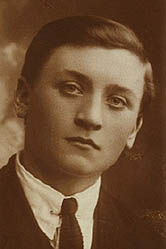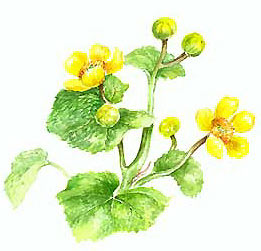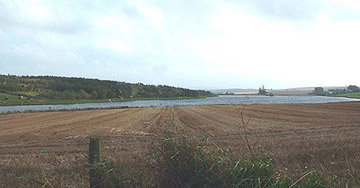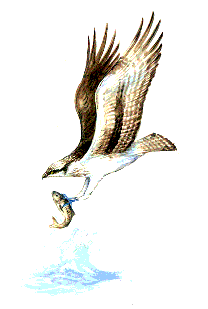The John Murdoch Henderson Collection
The Collector - His Life
Part I - A Buchan Farmer's Son
 Prolific
composer, musician and avid collector of music, John Murdoch Henderson
was born on 31st March, 1902, at Nether Oldwhat, a small farm by New Deer,
Aberdeenshire. The second son of farmer Charles Henderson and Mary Jane
Murdoch, he grew up in the heart of Buchan's farmland with his older brother,
Charles and younger sisters Mary Helen, Esther and Jeannie.
Prolific
composer, musician and avid collector of music, John Murdoch Henderson
was born on 31st March, 1902, at Nether Oldwhat, a small farm by New Deer,
Aberdeenshire. The second son of farmer Charles Henderson and Mary Jane
Murdoch, he grew up in the heart of Buchan's farmland with his older brother,
Charles and younger sisters Mary Helen, Esther and Jeannie.
After attending the local village school at Oldwhat, he became "Dux" (a Scottish senior school's most successful scholar) at New Deer Secondary School, an achievement which he later repeated at Peterhead Academy. Earning a place at the University of Aberdeen, Henderson studied both the arts and sciences graduating MA in 1926.
Photo: A Young John Murdoch Henderson
As a teacher of general sciences, he took his first professional post at the Frederick Street School in Aberdeen before moving on to Ruthieston School where he taught mathematics and the sciences.
From an early age Henderson took a lively interest in the musical culture of his native land, the fiddle tunes and songs of Buchan. He also had a deep passion for the countryside around his home and grew to become an accomplished botanist and ornithologist. He wrote articles on the subject for numerous publications including "The Scottish Naturalist."

Nether Oldwhat (pronounced locally "Al-Fat"), October 2001
Henderson's niece, Gladys, remembers her uncle John as "a typically canny Buchan lad" who regularly cycled the 35 miles from Aberdeen to his family home at Oldwhat where he liked nothing better than a farmhouse dinner of "chappit kale and oatcakes" or "skirlie and tatties."
 She recalls the many times John took his nieces and nephews on long countryside
walks, explaining many of natures mysteries and teaching them the names
of the local wild flowers and plants - coltsfoot, speedwell, marsh marigolds
and the many more that grew by their Buchan home. It gave the youngsters
a greater understanding of their surroundings and in so doing, helped them
all to develop a deep respect for the natural world.
She recalls the many times John took his nieces and nephews on long countryside
walks, explaining many of natures mysteries and teaching them the names
of the local wild flowers and plants - coltsfoot, speedwell, marsh marigolds
and the many more that grew by their Buchan home. It gave the youngsters
a greater understanding of their surroundings and in so doing, helped them
all to develop a deep respect for the natural world.
Marsh Marigolds - Caltha palustris
Henderson's boyhood interest in wild flowers and wildlife led to a life
long study of botany and natural history.
During his student days in Aberdeen, Henderson suffered a very close call when he fell from the cliff tops of Nigg Bay as he searched for botanical specimens. After a long struggle the Coastguard managed to get him safely back to the cliff tops, using a chair lift and with help from a number of people who had gathered around the incident. He was taken to hospital in a very serious condition and his recovery was to prove to be a slow and painful one. He spent several months in convalescence at his family home during which time he made regular excursions to the nearby Broch Dam where he enjoyed fishing and observing the wild life.
The Press and Journal reported the "Accident at Nigg Bay" in 1925:
"Student's Fall Over Rocks"
From the Press and Journal, 1925
Accident at Nigg Bay - COASTGUARD ORGANISES RESCUE.
A serious accident, which occurred at the Bay of Nigg, near Aberdeen, on Saturday, serves as another reminder to holiday-makers that the rocks which skirt the bay, though picturesque, are dangerous. The victim of the accident, who now lies in a critical condition in the Infirmary, is a young University student, Mr John M Henderson, who hails from Nether Oldwhat, New Deer, and resides in lodgings at 36 Summerfield Terrace, Aberdeen. He is a fifth year Arts and Science student. It is understood that Mr Henderson was searching for botanical specimens, when he fell over a cliff.
The accident occurred at Gregness, almost at the south end of the bay, at a point where the sea has cut out a deep gully and where a rocky cliff rises 40 feet high at the end of a miniature peninsula. The young man was seen walking along the top of the shore cliffs about 8 o'clock in the morning by Mr Henry Joyce, coast guardsman. It was two hours later before it became known that anything was amiss.
Cries for Help.
At 10 o'clock a young lady - Miss Archibald, who resides in Mount Street,
was walking along the top of the cliffs, when she heard someone moaning
and calling feebly for help. Running along to where a grass-topped natural
bridge connects the ridge of rocks with the beach cliffs, she found a
comparatively easy descent, and scrambling along as fast as she could,
she came upon Mr Henderson lying in a pool of blood on a sloping ledge.
Evidently he had just recovered consciousness. The girl tried to move
him into a comfortable position, and filling her hat with water, she
washed the blood from an ugly wound in his forehead. She then scrambled
up the way she had descended and ran to the coastguard station with news
of the accident.
Mr Joyce, accompanied by two joiners who were engaged on repair work at the coastguard station, hurried to the scene of the accident, which was only about a hundred yards away. The beach cliff at the spot is 70 feet high and it was impossible to say whether it was from it, or from the somewhat lower rock at the other side of the gully, that the student had fallen. Mr Joyce at once saw that the young man was in a serious condition and that for the rescuers to scramble up the rock with him would be a dangerous expedient. Accordingly, he ran back to the station for some ropes and a "bo'sn's chair," which was lowered from the top of the beach cliff.
Hauled Up Cliff Side.
Mr Henderson was set in the chair, lashed securely to the ropes and hauled
up over the cliff. A number of men, who had been attracted to the spot
by observing that something unusual was going on, assisted in the operation
and some of them stood on the steep side of the rock and prevented Mr
Henderson from being dashed against it as he swung in mid-air.
Meantime Mrs Joyce, the coastguardsman's wife, though only a few days convalescent
after a severe illness, ran all the way from the station to the Girdleness
Lighthouse to telephone to Aberdeen for an ambulance. The St. Andrew's
Ambulance was promptly on the scene and Mr Henderson was removed to the
Royal Infirmary, where it was found he had sustained fractures of his jawbone,
both his wrists and one of his ankles, besides a severe cut on his forehead
and several other cuts and bruises.
On inquiry at the Infirmary last night, it was learned that Mr Henderson,
while progressing as satisfactorily as could be expected, was still in
a critical condition.
The Last of the Buchan Ospreys
In July 1953, "The Scottish Naturalist" published
an essay by Henderson. "The Osprey In The North East" gave an
account of the ospreys that fished Loch Riach, the Broch Dam at Bonnykelly,
a half mile from his home. He first saw an osprey at the Dam in the summer
of 1925 and wrote of how much he enjoyed the spectacle of the birds' pounce
and plunge as they took fish from the waters of the loch. The article sadly
concludes that the last of the Bonnykelly Ospreys was fatally wounded by
gunshot in the summer of 1929.
The Osprey in the North East of Scotland by J. Murdoch Henderson
From "The Scottish Naturalist" - Spring Number, July 1953
In the early 1920s it was known, at least in certain intimate circles,
that ospreys were being reared with protective supervision, presumably
under the direction or inspiration of Capt. Knight, in woods by the river
Deveron, near the line dividing the counties of Aberdeen and Banff.

Loch Riach, "The Broch Dam" where Henderson observed the ospreys in the 1920s
![]() Loch
Riach, played by Duncan Wood. JMH 1933
Loch
Riach, played by Duncan Wood. JMH 1933
Concrete evidence of the laudable venture first came to my notice twenty-eight summers ago when I was recovering from a serious physical breakdown - one which I may add in no way dimmed or distorted my vision! I was staying less than half a mile from the Fedderate Reservoir, an artificial loch of twenty-five acres, christened Loch Riach, unofficially, but better known locally as the "Broch Dam." This rather bleak anglers haunt, constructed during the years 1910 - 1912 to form the main water supply to the Burgh of Fraserburgh, is fed by two gentle streams from the western side of the Bonnykelly district, some five miles north of New Deer.
From the last week of July, 1925, and during every morning for more than a fortnight, four ospreys - at least some of them obviously juveniles, came to the loch. Much of their time they spent calling, raucously and anxiously, from the tops of fencing posts on the adjoining croft, then tenanted by Mr James Scott, since deceased. Mr Scott's daughter Mary, now Mrs Greig, Fraserburgh, witnessed them regularly at near range, but their penetrating, persistent cries certainly claimed the attention of other workers on the five neighbouring crofts. I, too, heard and saw the grand birds, and had the honour first to identify them there, but I had not quite regained the mobility to study their general behaviour from closer quarters. One forenoon in August, however, I followed them with a two and a half inch telescope, at a distance of fifty yards and upwards, as they flew from post to post in south-easterly direction alongside the compensation water from the reservoir, until slowly and silently they passed from view. I did not see them again, and I cannot recall mention of there having been seen by anyone else during the remainder of that year.
 From
the latter half of the 1929 spring, moreover, one bird - presumably an
adult, possibly a breeding bird, fished the loch. The daily spectacle of
the pounce and plunge for the kill greatly excited the curiosity of the
near, and even some of the more remote inhabitants. For landing its prey
this bird appeared invariably to chose the same point of vantage, which
I examined for possible "fishprints", etc., when I returned
to the scene early in July of that year - the top of a tall staining post,
in the east corner of the nearest field on the Upper Oldwhat holding them
farmed by Mr William Willox. Mr John Willox, his younger son, a keen sportsman
and naturalist who now owns the Ythan Garage near Ellon, gave much of his
leisure and more to studying this osprey and trying to dissuade the unscrupulous
from harming it. The sad, despairing news, alas! reached him in late June
that this noble, pioneering bird, which by then had ceased to distinguish
the area with its presence, had been wantonly wounded by gunshot from the
northern, Whitecairns side of the reservoir.
From
the latter half of the 1929 spring, moreover, one bird - presumably an
adult, possibly a breeding bird, fished the loch. The daily spectacle of
the pounce and plunge for the kill greatly excited the curiosity of the
near, and even some of the more remote inhabitants. For landing its prey
this bird appeared invariably to chose the same point of vantage, which
I examined for possible "fishprints", etc., when I returned
to the scene early in July of that year - the top of a tall staining post,
in the east corner of the nearest field on the Upper Oldwhat holding them
farmed by Mr William Willox. Mr John Willox, his younger son, a keen sportsman
and naturalist who now owns the Ythan Garage near Ellon, gave much of his
leisure and more to studying this osprey and trying to dissuade the unscrupulous
from harming it. The sad, despairing news, alas! reached him in late June
that this noble, pioneering bird, which by then had ceased to distinguish
the area with its presence, had been wantonly wounded by gunshot from the
northern, Whitecairns side of the reservoir.
Illustration: "The daily spectacle of the pounce and plunge for the kill greatly excited the curiosity . ."
Readers will readily appreciate that the above is the first eyewitness account of the Loch Riach visiting ospreys to be published through any of the normal channels. I even withheld the details from the late H. F. Witherby and his world-famous "Handbook" in the interests of the species. As no subsequent occurrences of this rare fish-hawk have been observed in the district, however, I have been stimulated and persuaded by Professor V. C. Wynne-Edwards to have these authentic records preserved in this eminently appropriate journal.
J. Murdoch Henderson, Aberdeen.
Press & Journal, November 11th 1972 | Friend's last tribute to N.E.'s "Man of Music"
Henderson died in Aberdeen, in November 1972. The following tribute from William Hardy, a friend and fellow fiddle player, was published in the Press and Journal newspaper a few days later:
. . . . We have received the following tribute in connection with the death of retired Aberdeen teacher Mr. John Murdoch , Henderson(70) of 15, Craigton Rd from Mr William Hardie of. 350, Holborn Street Aberdeen, a close friend.
With the sudden death of Mr John Murdoch Henderson a week past Friday, Aberdeen not only lost an ex-school teacher of maths and science, but the North East and indeed the whole of Scotland, surely lost its most gifted and brilliant composer since the late J. Scott Skinner, in the field of our national instrumental music.
Besides being a composer of such distinction in
his own right, he also dedicated a great part of his life to research
and rescue from oblivion of Scots music traditional, and from the earliest
composers onwards. In this prodigious task he inevitably built up an
enormous collection. He early became an ardent admirer of James Scott
Skinner, George T. Taylor and James F. Dickie, the New Deer violinist
who, at the height of his powers, was a player of truly exceptional ability,
style and taste. After Scott Skinner's death in 1927, Murdoch Henderson
became the secretary of the J. Scott Skinner Memorial Committee and was
very active as conductor, etc., in fund-raising concerts which culminated
in the fine memorial erected at Allenvale Cemetery in 1931. He was also
responsible for the inclusion of J. Scott Skinner among the "greats" in
Grove's Dictionary of Music.
For some time before World War II, Murdoch Henderson, due to his undoubted
eminence as the authority on strathspey and reel violin playing was in
demand as adjudicator at competitions. During his years as organiser of
the Scots Instrumental Section of the Aberdeen and North East Music Festival,
this section enjoyed great popularity.
The J. Murdoch Henderson trophies donated by him are a lasting reminder
of this period of his participation in the musical life of the North East.
He published "Flowers of Scottish Melody" in 1935 and "The
Scottish Music Maker" in 1957, besides some sheet music in the intervening
years. Latterly he had been occupied in preparing further works for publication.
A keen nature-lover, he enjoyed bird-watching, botany and gardening.
By kind permission of the Press and Journal, 2001

